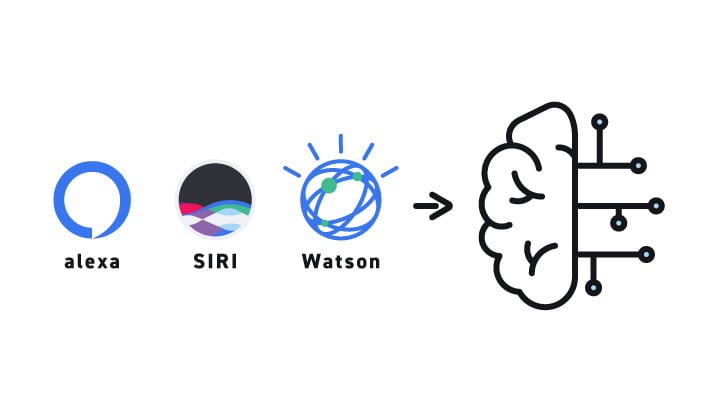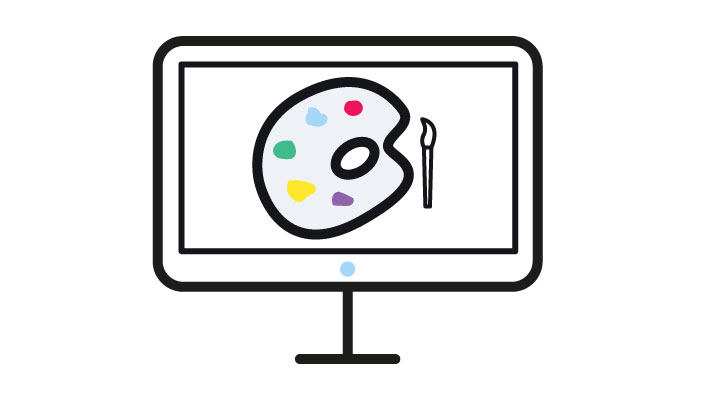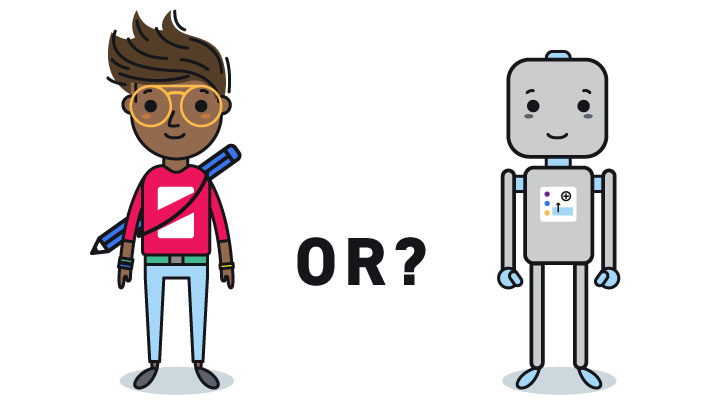Technology innovation continues to impact humans. One of the hottest buzzwords in the media today is artificial intelligence, or AI. If you believe the marketing hype, AI is everywhere, including in our phones, homes, businesses, and even our toothbrushes. But the reality is that there is a big difference between the scary sci-fi AI and the real-life computer algorithms powering your Alexa.
The truth behind the media buzz is that AI isn’t here yet, but it’s coming. Advances in the computer sciences have made our machines into smarter and more intuitive tools that are now encroaching into the single area that makes human beings powerful: the creative arts.
Here’s how the computers of the future will impact your job in the creative fields.
Understanding AI

The first thing to understand about AI is that it doesn’t exist yet. The term “AI” has been used to describe anything that a computer can be programmed to do automatically, like track your heart rate or your Facebook search patterns. Your voice-enabled Alexa or Siri isn’t AI, but there are programming elements in the device that AI might someday use. AI isn’t robots, either, but AI can be used in robotic technology.
ZDNet defines true AI as “the type of adaptable intellect found in humans, a flexible form of intelligence capable of learning how to carry out vastly different tasks.” Today, we have parts and pieces of AI that are the precursor to this intellect. According to this definition, artificial intelligence will exist when the computer becomes us. Imagine Skynet from the Terminator movies or Hal 9000 from 2001: A Space Odyssey. Or perhaps real AI will be something totally different that we haven’t imagined yet.
IBM’s Watson is a supercomputer that perhaps comes the closest to AI. It processes data at 80 teraflops across 90 servers with 200 million pages of information against six million logic rules. In layman’s terms, that means it’s super smart and can answer questions really fast. But people are behind all the logic — human computer programmers are still the creators of these tools. The idea of AI is that the computers won’t need us to improve them anymore and will become their own thinking, logical, and possibly emotional entities, separate from, but at least equal to, the human brain.
Today, there are dozens of companies trying to figure AI out by using the algorithms we’ve developed to solve business problems. Amazon has an AI wannabe, as do Google, Intel, Microsoft, Salesforce, and Siemens. There are also a ton of startups using big computing to do new things by programming software algorithms that make these devices more intuitive to use. Someday, these algorithms may evolve computers into sentient decision makers, an idea known as singularity. (Here are some of the coolest AI companies so far.)
The latest advancements in the field of computer science are not true artificial intelligence, but instead more marketing ploys to pique your interest in buying more digital stuff. So, when the manufacturer tells you that your toothbrush has AI, understand that the reality doesn’t quite match the marketing.
The idea of sentient computers that could rule the planet is scary (and intriguing), but we aren’t there yet. However, it’s the potential of this idea that freaks out people like Bill Gates, Elon Musk, and the late, great Stephen Hawking, who all warned that AI could cause serious damage to humans if it ever becomes a reality.
It might be time to worry about this, at least a little, because there are increasing signs that we are closer to the reality of AI. For example, Facebook shut down two chatbots recently that started talking in their own language, incomprehensible to humans. There’s also Sophia, an eerily human-looking robot that just became a citizen in Saudi Arabia.
But 63% of the human population says that AI can, will, and should be harnessed for good, solving problems that currently seem insurmountable, like, perhaps, climate change. (No one has polled computers to see how they feel about taking this on.)
Some of the missing elements that keep the average computer from turning into AI are the characteristics that set us apart from other mammals, such as our ability to be creative. Is creativity an element that programmers can work into an AI algorithm?
Are AIs Creative?

“Artificial intelligences could give human creatives a run for their money, perhaps not only competing with us but triumphing over us.”
~John Tuttle, Hacker Noon
There are thousands of computer programmers working to evolve a machine into something that has never been seen before — and there are signs that they are getting close. For example, there are now computers that can invent their own languages (see the prior Facebook example) and even compose music.
Composing, like all other creative endeavors, is not something your home computer can do without you behind the keypad. However, it is something supercomputers like Watson can take on. It’s likely that you’ve heard these tunes without realizing it, because over the past decade, AI wannabe programs have been creating music for smartphone apps, games, advertisements, and even films.
Computer scientists call it “algorithmic composition.” It’s a set of mathematical equations in computer language that tells the machine to automatically generate musical compositions. The computers, with their speedy hyper-processors, can create a full symphony in minutes. New Atlas points out the obvious: “Algorithms that produce creative work have a significant benefit, then, in terms of time, energy, and money, as they reduce the wasted effort on failed ideas.”
Check out Easy Music Composer for Android. There’s also Melomics109, an (almost) AI program focused exclusively on making music. This machine has made albums without human editing on the front end, powered by human-created algorithms on the back end. These algorithms are designed to help the machine improve each time it creates something new. It’s the same technology found in your home Alexa, which takes human input and improves its responses each time you interact with it.
But it’s not just music composition that these almost real AIs are taking on. A computer-generated painting just sold for $432,500 at Christie’s. The computer that generated it was programmed with an algorithm that trolled brush strokes and other data from a collection of historical paintings and then created something new. This was the brainchild of a firm called OBVIOUS, whose tagline “artificial intelligence for art” is as interesting as it is potentially controversial. The company is careful to suggest that it is the collaboration between computers and humans that interests them the most: “We believe that a new generation of creators will rise, one that will know how to best build and manage algorithms that will help in an innovative process.”
So, computers can now make their own music and paint like Rembrandt. But can they write a novel like Jack Kerouac? The answer is yes, according to The Atlantic, which chronicled the efforts of writer Ross Goodwin to use modern computer tools to create poetry, screenplays, and now, the great American novel. Goodwin filled a Cadillac with homegrown electronic sensors and cameras and attached the sensory input to a sophisticated computer network that turned the visuals and geodata from his trip between the East Coast and New Orleans into prose.
As a first step, it’s interesting, but from an editor’s perspective, Goodwin says, “It’s not quite human level, more like an insect brain that’s learned to write.”
If all of this is starting to make you nervous about your job in the creative field, that’s no surprise — it probably should. GarageBand is one thing but now computers can make entire albums. What’s next? Singing? Actually, yes, because last year, Google created Tacotron 2, which creates sounds that are indistinguishable from the human voice.
Now we have computers that can talk like us, process information faster than the human brain, and produce works of art that make us feel things. It’s okay to feel creeped out and even threatened by computers that haven’t reached AI level but are still producing and selling art and making symphonies. If they can do all this, what could AI do? Well, evidently, they can and will dream.
IFLScience! reports that Google computers, which are linked together in a neural network, can now visually identify images. Visual recognition of a common item is no big deal to most humans, but computers looking at a fork, recognizing the visual characteristics of the object, and labeling an eating utensil is something we haven’t witnessed from a computer before. Scientists call this process “dreaming” and it produces some weird and interesting iterations of what computers see and interpret. Google recently held an art exhibition that made thousands selling computer-generated visualizations.
(Check out Google’s Deep Dream Generator for more AI-powered art.)
It seems like we’re heading to a point in our evolution where art isn’t what defines us as human anymore. One question for people that work in the creative fields is, how will these increasingly sophisticated computers impact our jobs in the future?
Should Creative People Worry About Losing Their Jobs to Robots?

Now we can get down to the real concern about AI, which is the idea that someday a bot could replace the career paths of thousands of aspiring workers in the creative fields. Forget world domination, could AI, when it finally arrives, replace Graphic Designers, 3D Animators, Copywriters, and Editors?
Of course, we all use computers do our jobs. Software powers the world of digital production in every field. But using Illustrator to color a graphic is a lot different from losing a screenwriting job to a computer.
Adobe has been trying to quantify how creative professionals feel about the encroachment of computers into the creative space. They commissioned a consulting firm to survey creative workers to determine their attitudes about AI innovation and its impact on their work. The research handpicked creative professionals from some of the biggest companies in the world, from Apple and Adidas to Pepsi and Panasonic. What they found was that, contrary to what many pessimists would imagine, creative professionals found AI less threatening and more intriguing. Only 9% said they were extremely worried that AI would take their jobs. The study suggested that these professionals believe it’s still our creativity that sets us apart as human. Researchers surmised that AI in some ways has been an insidious presence; the algorithms that make up the technology are peppered throughout the tools we now use every day. The study showed that the vast majority of respondents view AI as a way to automate redundant tasks and free up their time. The study showed creative professionals would overwhelmingly use an AI assistant if it:
- Reduced drudgery (89%)
- Taught them new software features (81%)
- Provided a more streamlined image search (77%)
The study concluded:
“AI has the potential to alleviate many tasks that are perceived as tedious or repetitive. With the help of AI…creative assistants have the potential to significantly speed up these tasks. This liberation from mundane tasks allows creative professionals to increase the focus on their personal creativity, bold new ideas, and better client collaboration.”
The bottom line is that most creative professionals seem comfortable with imminent AI advances, viewing innovation as a positive instead of a threat. We should note, though, that the three perceived benefits of AI in the study come from computer algorithms that are not AI. Remember, AI is when the computers out-human us, rising up to be smarter, faster, and more creative than we are.
One thing is certain: the jobs of the future will make use of these tools in new collaborations to reach audiences in our increasingly complex and digitized world.
If you’re a creative professional seeking new ways to hone your skills, talk with the team at Artisan Talent. We can help.




